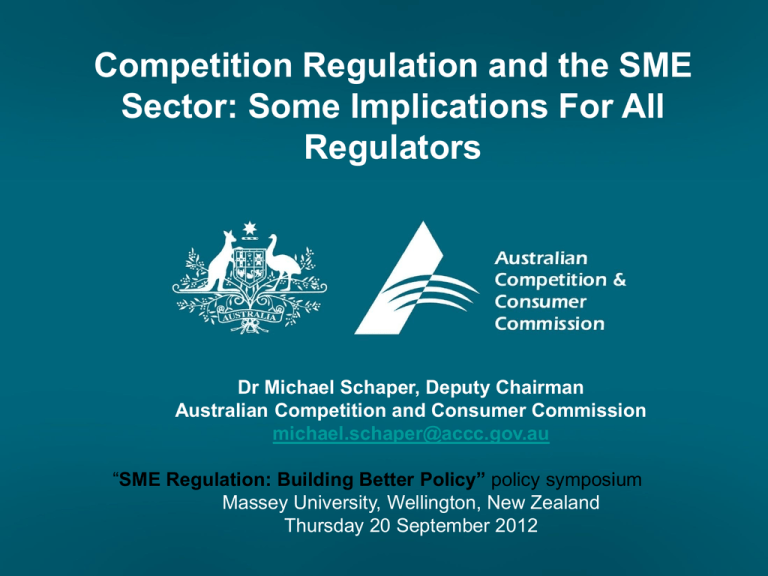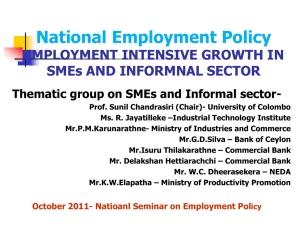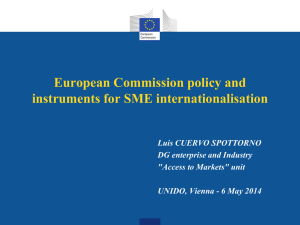SME Regulation - Australian Competition and Consumer Commission
advertisement

Competition Regulation and the SME Sector: Some Implications For All Regulators Dr Michael Schaper, Deputy Chairman Australian Competition and Consumer Commission michael.schaper@accc.gov.au “SME Regulation: Building Better Policy” policy symposium Massey University, Wellington, New Zealand Thursday 20 September 2012 Overview 1. SMEs and Regulation - Growing demands - Different worldviews 2. Competition Regulation and Small Firms - What it is and why we do it - SME specific issues - Micro impact - Macro-level impact 3. Some Reflections and Observations - Key issues - Some future research directions 1. SMEs Face A Growing Array of Different Types of Regulation These can be both generic… • Occupational health & safety (OHS) • Labour laws • Environmental • Corporation laws/corporate governance • Zoning & planning • Taxation • Competition ...+ their own industry-specific rules: • Specific Acts and statutory rules • Industry codes of conduct (voluntary/mandatory) ...and the volume of regulation also grows NSW Vic Qld SA WA Tas NT ACT Acts 32,700 44,200 49,400 16,500 40,700 13,200 17,000 21,800 Statutory Rules 7,700 Total 40,400 56,800 65,000 25,000 63,500 25,200 21,000 29,600 12,600 15,600 8,500 22,800 12,000 4,000 7,800 Number of regulatory pages across Australian states/territories in 2007 Source: Productivity Commission, Australia (2008:32) The Different Worlds Of Regulators And Entrepreneurs Regulator SME Owner-Manager Education Law, economics, public administration Highly variable Accountability Public Private & personal Work background Public administration Private sector Industry experience None or minimal Extensive Knowledge of laws Extensive Ad-hoc Reward basis Ensuring full compliance Penalty avoidance Cost of regulation Nil Usually total Regulatory focus Narrow; specific Whole of business Timeframes Lengthy Short Problems For Regulators Dealing With The SME Sector Small firms: • Limited membership of industry associations • Subject to high levels of churn • Lack specialist regulatory compliance skills • Suffer from information asymmetry • Hard to detect breaches and non-compliance • Court-based legal processes: their strengths and weaknesses • The need for alternate dispute/grievance resolution mechanisms Internally within the regulatory agency: • Lack of practical industry experience • Excessive legalism/conservatism in external liaison • Over-focus on responsibilities; little mention of rights Regulators need to emphasise rights as well as responsibilities 2. Competition Regulation The range of laws, policies, institutions and procedures enacted to produce particular market outcomes in a society Varies from nation to nation, but usually covers: • Merger & acquisition approvals • Policing of anti-competitive behaviour (cartels, pricefixing, market collusion, third-line forcing) • Supervision of regulated industries/natural monopolies (telecomms, postage, transport, infrastructure) • Consumer protection (misleading & deceptive conduct, pyramid selling, bait advertising, product safety) • Pricing, warranties rules Does Competition Regulation Help or Hinder SMEs? In theory: • Free and fair competition central to entrepreneurial success • Allows new, dynamic firms to access markets • Allow new innovations to market • Give consumers greater choice • Culls ineffective firms …all part of Schumpeter’s notion of creative destruction ...But SMEs Often Have Unique Problems • • • • • • • • Geographically limited Possess a limited product and service range Limited market share Subject to high levels of churn Suffer from information asymmetry Less likely to access established suppliers Usually unincorporated Limited access to skilled advice Competition regulation therefore has an impact at both the micro and macro-level Source: M.T. Schaper (2012) “Competition Regulation, Open Markets and Small Business” European Competition Law Review, No.8, pp.333-338. A Key Issue... Should competition regulation seek to provide a “level playing field” (everyone has an equal chance) or… Assume that SMEs are at a disadvantage, and give them special protection? Do we protect competition, or the competitors? Micro-Level Impact of Regulation: How Do SMEs Respond To Competition Law? UK evidence: • 1/3 of firms are aware of anti-competitive practices • Most likely response is to “get on with it” • SMEs prefer to compete or ignore threats, rather than report to regulators • Larger firms more likely to work with regulators than small, micro-sized ones Source: Storey, D.J. (2010) “The Competitive Experience of UK SMEs: Fair and Unfair” Small Enterprise Research Vol.17 No.1, pp.19-29. It can be tough out there… The Australian Experience • Approx. 2 million trading SMEs • The ACCC receives about 5,500 queries from SMEs per annum – 40% are just queries/request for more info and 60% complaints. • We also get about 2,000 complaints by consumers against SMEs each year. • Common issues of concern for SMEs: – Contractual disputes – False & misleading claims by other businesses – Queries about consumer guarantees and refunds – Advertising and pricing issues – Possible business scams – Complaints manufacturers or distributors have refused supply Do SMEs Exercise Their Legal Rights? • SMEs often unaware of their rights & obligations • Most firms don’t want formal legal redress – just an effective resolution of their problems • Often unable/unwilling to collect necessary evidence • Litigation is time consuming… • …and expensive • Informal settlements & undertakings often more effective • Often unaware of alternate dispute resolution mechanisms available (i.e. mediation) Macro-Level Impact of Competition Regulation: Is It A Common Good Or A Detriment? The common assumption: …when regulators force markets to open up and industry protection is removed, SMEs will be squeezed out of existence by bigger, more aggressive competitors Is this true? Extending Competition Regulation: The Australian Example 1974-1995: Australian competition laws did not apply to most SMEs: sole traders, partnerships and the professions were exempt Most of these were micro-firms 1995: Australian laws harmonised to extend coverage to all these groups …A giant laboratory experiment So, what happened to them? Competition Regulation Changes Lead To Growing Business Numbers 2,500,000 2,000,000 Small Medium Large 1,500,000 1,000,000 500,000 0 1983 1999 2007 So, What Happened? Total number of SMEs grows substantially: 1995: 930,000 SMEs in Australia 2005: 2 million SMEs Proportion of micro-businesses also grows: 1995: 80% of all firms 2005: 84% Open market regulation lead to growing numbers of small businesses 3. General Observations • Overall level of regulation is growing • Regulators and SMEs often do live in different worlds • Need to consider both micro-level and macrolevel impacts of regulation: – Individual firms often just manage “as best they can” – ...or laws may just be irrelevant to many – But can also help the sector as a whole From SME Advocate To Regulator: Some Personal Reflections • SMEs are not big firms – tailor your approach • Need to explain both rights and responsibilities • Outreach & education must be on-going and tailored to needs of SMEs • Enforcement must be appropriate & proportional • Still need to do more evaluation of our effectiveness • Need more SME champions on regulatory decisionmaking bodies • Regulators need more practical industry experience Possible Areas of Useful Future Research Perceptions and knowledge: • What opinions and preconceptions do regulators have about SMEs? • How much do SMEs know about their regulatory responsibilities (“regulatory literacy”)? • How do we effectively disseminate info to them? Influence of third parties: • What impact do industry groups (and others) have on the ability of SMEs to comply with regulation? Regulatory compliance: • What is the real level of burden & impact of increased compliance? • How frequently do SMEs really comply with the law, or just ignore it? www.accc.gov.au









